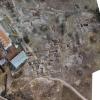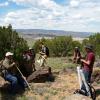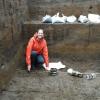Academic department of Anthropology
Inland Zanzibar Archaeological Survey
Wari Foodways: A view from the Urban Core of Huari (AD 600-1000)
In January of 2019, the Stahl fund enabled me to travel to Ayacucho, Peru for analysis and collection of dissertation materials recovered from a domestic sector of the city of Huari (AD 600-1000). This trip allowed me to analyze charred botanical remains collected during excavation and artifacts recovered through flotation samples I processed through the 2017 and 2018 field seasons of the Huari Urban Prehistory Project co-directed through the University of Binghamton and the Universidad Nacional de San Cristobal de Huamanga.
Community-Accountable Archaeology with Community Partners
This field season included collaboration with and within the research agendas outlined by the Merced Board at Abiquiú, the descendants and land owners of the main plaza at Conejos CO, the Pueblo of Picuris, NM and with the help of a small crew of experienced excavators, analysts, and local community leaders.The Merced del Pueblo de Abiquiu Community Board has identified several excavation-based research opportunities for their community regarding the first use dates of some of their ancestral agricultural fields, plazas, and acequias and requested that we report to them during their annual
Sannai Maruyama
Project: Sannai Maruyama
The Berkeley Sannai Maruyama Project
From Summer 1997 to Summer 2007, Junko Habu and her students collected soil samples from multiple test excavation areas of the Sannai Maruyama site. Archival research of excavation report of Jomon sites in Aomori Prefecture was also conducted. These works were done in collaboration with the Preservation Office of the Sannai Maruyama Site.
Resilience and Foodways at La Chiripa, a Prehispanic Household in Arenal, Costa Rica
My research investigates the human-environmental interactions of Prehispanic peoples in the Arenal region of Costa Rica. This area is an ideal location to look at resilient practices in the past, since domestic settlements in Arenal persevered through powerful volcanic eruptions that impacted the landscape every few centuries.
Distributional (Siteless) Survey in the Environs of Kharaneh IV
Residential Mobility, Food Diversity and Landscape Practice at the Goshono Site, Iwate Prefecture
Together with two Berkeley graduate students and one undergraduate apprentice, I conducted field and laboratory research in Japan in summer 2020 1) to analyze floral remains obtained from the Middle Jomon Goshono site, Ichinohe Town, Iwate Prefecture, and 2) to process additional soil samples for further analysis. At the laboratory of the Research Institute for Humanity and Nature in Kyoto, we floated soil samples that were previously collected from several pit-dwellings within the site, and sorted both the light and heavy fractions with a guidance from Dr. Yumiko Ito of Aomori Prefecture.
Ancient Explorers of Cyprus: Traversing Land and Sea in the Epipalaeolithic
The Ancient Seafaring Explorers in Cyprus (ASEC) project conducted its inaugural field season from September 10-September 20, 2019. The goals of the project are to investigate the earliest occupation of the island, specifically the Late Epi-Palaeolithic through early Neolithic periods, (ca. 10,000 -8000 years ago). The project aims to reveal evidence for the nature of these early hunter-gatherer occupations at sites on the south coast of Cyprus, both on land and those submerged by rising sea levels over subsequent millennia.
Identification, Institutionalization, and Landscapes of Reuse at Tuberculosis Sanatorium Sites
The Historical Archaeology Sanatorium Project focuses on tuberculosis sanatoria in California during the early twentieth century. This project investigates issues related to disability, stigma, health, identity, and archaeologies of institutions in order to understand social aspects of health and disease. The Weimar Joint Counties Sanatorium was originally a government operated tuberculosis hospital for patients who were unable to pay for treatment elsewhere.















